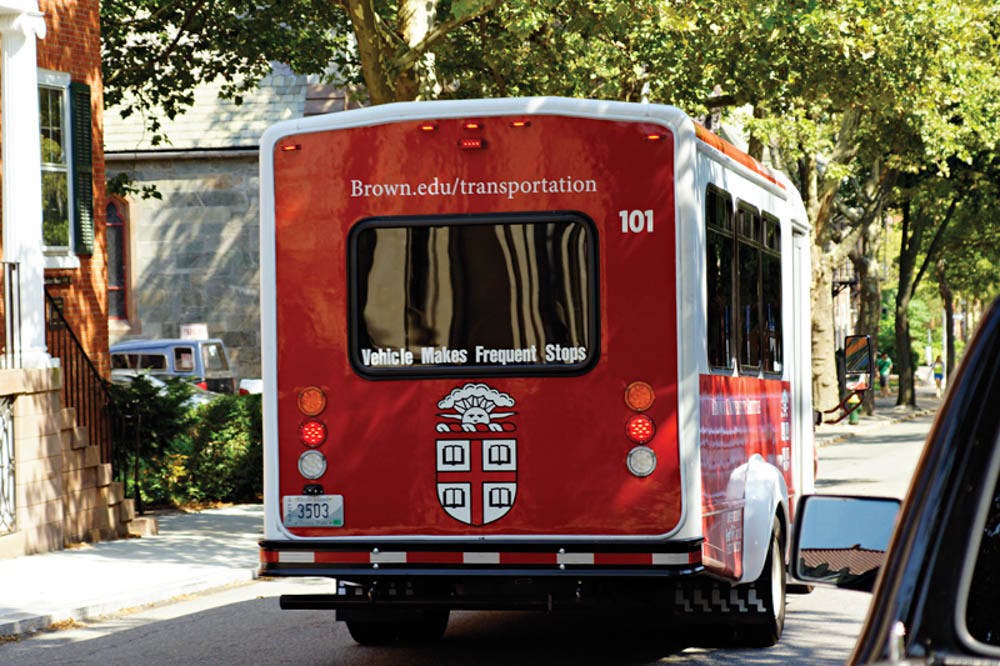On weeknights, Brown University Shuttle driver Danilo Paulino takes buses of students back and forth between downtown Providence and Brown’s campus on College Hill, each passenger masked and seated six feet apart from the next. Twisting down Prospect and Waterman Street, he follows a new route that connects students to their University-leased off-campus housing, going as far as the Jewelry District and the Omni Providence Hotel multiple times a night.
When Paulino immigrated to the United States from the Dominican Republic in 1980, it was difficult for him to to find work because his education credentials did not translate to the American job market. But Paulino eventually began working for the Rhode Island Public Transit Authority, driving buses for 20 years.
At the start of the fall 2020 semester, Paulino was browsing job postings on the internet when he came across a listing for a position with BUS, which was recruiting new drivers to take on its off-campus route.
“I saw it on the internet, and just filled out an application,” he said. Soon thereafter, he was trained by another driver and given the position. Paulino has been driving for BUS since.
“I like it,” Paulino said. “The students are very decent, very educated.”
As part of the University’s effort to de-densify its campus for the spring semester while inviting students from all class years back, students were each given their own rooms, leading the University to seek additional off-campus housing for its student body. Likewise, the University had to increase its BUS operations to incorporate students farther away from campus, as well as getting more drivers to accommodate new social distancing guidelines within the bus.
“There were two changes made to the shuttle routes for the spring semester. The first was the addition of the Omni Shuttle which ran daytime between the Omni and College Hill,” Elizabeth Gentry, assistant vice president for business and financial services, wrote in an email to The Herald.
“The second change was to add the Omni to the evening route which serviced the Omni, the two Chestnut Street properties and the River House and College Hill,” she added.
Additionally, there has been an increase in onCall shuttles “which correlates to the increase in the number of students on campus this spring,” Gentry wrote. The onCall shuttle program “provides a point-to-point ride service to and from areas not accommodated by the Brown Evening Shuttle Route” for individual students, according to a Brown University Shuttle infographic.
BUS has adopted a number of measures to accommodate University and state public health guidelines during the pandemic. These measures come “as part of our commitment to protecting the health of both riders and drivers,” Gentry wrote.
One adjustment has been the reduction of passenger capacity on shuttles by 50 percent. This has created an increase in the individual shuttles necessary to serve the student body, leading “Brown (to secure) additional shuttles to ensure the demand for shuttle service would continue to be met,” Gentry added.
Additionally, seat restrictors and plexiglass dividers have been placed in the shuttles to ensure proper social distancing for riders with both other riders and drivers. All drivers and passengers are required to wear a mask or face covering while riding the shuttle.
Transportation Services also requires periodical cleaning of the shuttles throughout the day, including “special attention to high-touch areas” that students might more frequently come into contact with, Gentry wrote.
But despite the increased bus route offerings, drivers note that there are significantly fewer passengers on their average bus route.
“We’re not picking up as many students” compared to years prior to the pandemic, said Michele Machado, a BUS driver who drives shuttles two nights a week during the spring semester on the on-campus route. Machado began working part-time for BUS more than five years ago, and said she has never seen her bus so empty.
“In the beginning (of my time working for BUS) we had quite a few students,” she said. “We’d pick up, like, 200 a night. Now, it’s slowed down a lot.”
“Since COVID kicked in, there’s a big difference in the riding and the riders. I went from maybe 150 a night to maybe, (if) I’m lucky … 25,” said Terry Edmonds, who has driven for BUS for three years. This semester, she drives an on-campus shuttle every weeknight.
Edmonds suggested that this was due to a lack of in-person campus activities, which limited demand for students to travel across campus regularly.
Additionally, “the students are more into the fresh air,” she said. “Because of COVID it’s just wiser” to avoid communal spaces.
“Also, exercise has a lot to do with it, because they’ve been … forced to be in the house” for so long due to remote classes, she added, prompting them to opt for walking from one place to another rather than choosing to take the shuttle.
As the University plans its transition to fully in-person instruction for the fall 2021 semester, BUS will likely make changes again, with students filling every seat en route to whatever activities they might have planned on campus. Edmonds is eagerly awaiting the change.
“I love driving through the campus and seeing … all the different events, when the kids are dressed up,” she said. “And when they play instruments, they’re carting the instruments (and) they bring them on the shuttle … it was nice seeing all that.”
“I love the job. I didn’t really think working with college kids would be easy … but (the students are) very, very grateful,” Edmonds said. “Even when they’re drinking.”
“I would just love to see normalcy back,” she added, to “see the kids have the real college experience.”

Jack Walker served as senior editor of multimedia, social media and post- magazine for The Herald’s 132nd Editorial Board. Jack is an archaeology and literary arts concentrator from Thurmont, Maryland who previously covered the Grad School and staff and student labor beats.





